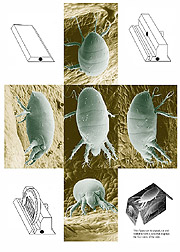What Mite You See With This Gadget? |
|
|
|
Not really insects, mites are more closely related to ticks and spiders and come in a variety of body shapes and sizes. Some are no bigger than the point of a needle. Yet they are a constant threat to economically important crops and stored grains, as well as to livestock, wildlife, and humans. The mite—or any other species of insect and nematode—can now be viewed more extensively by low-temperature scanning electron microscopy (LTSEM) when placed in a new holder designed by Agricultural Research Service botanist Eric Erbe. Standard specimen holders for LTSEM viewing can cost several hundred dollars each. The expense can sometimes curb experiments that require several holders. Holders are also limited by the tilt capabilities of the microscope's stage, which makes it difficult for researchers to see all sides of a specimen once it is placed into the microscope. Erbe's inexpensive specimen holder, made of scrap metal, allows a 90-degree tilt for observation of the edges of flat specimens. It can also be used to obtain side, front, and back views of specimens normally mounted with just the top side exposed. Rotating samples in this new holder between each observation and recording yields a series of micrographs that provides a 360-degree view of an object or specimen. In the field, scientists, extension agents, and farmers typically collect samples onto a copper-plate specimen holder—or even onto a penny if that's all that's available—and then contact freeze the specimen to keep it in optimal condition. To do this, they use a portable cryo-work chamber filled with liquid nitrogen, which freezes samples in milliseconds. Then they place the samples in a dry shipper, cooled to –321°F, and send them to ARS scientists in the Electron Microcopy Unit at Beltsville, Maryland, for examination. There, scientists place the frozen specimens in Erbe's special holders for observation under the LTSEM at up to 50,000x magnification. "The specially built holder is an important accessory for scientists interested in obtaining more complete descriptions of many small pests," says Erbe. "Accurate identifications will help prevent the annual economic losses they cause, estimated to be in the billions of dollars." Erbe has developed a unique display of insects and mites by turning these micrographs into what he calls box photos. A single photographed layout of the top and sides of a mite, insect, or nematode can be copied, cut, and folded to form a cube that displays the creature in three dimensions. You can design your own box photo by checking out our Science for Kids web site at http://www.ars.usda.gov/is/kids/weirdscience/story7/buildamite.htm.—By Jennifer Arnold, formerly with ARS. This research is part of Plant Diseases, an ARS National Program (#303) described on the World Wide Web at http://nps.ars.usda.gov. Eric Erbe is with the USDA-ARS Soybean Genomics Improvement Laboratory, Bldg. 177B, 10300 Baltimore Ave., Beltsville, MD 20705; phone (301) 504-8046, fax (301) 504-8923. |
|
"What Mite You See With This Gadget?" was published in the May 2002 issue of Agricultural Research magazine. |







